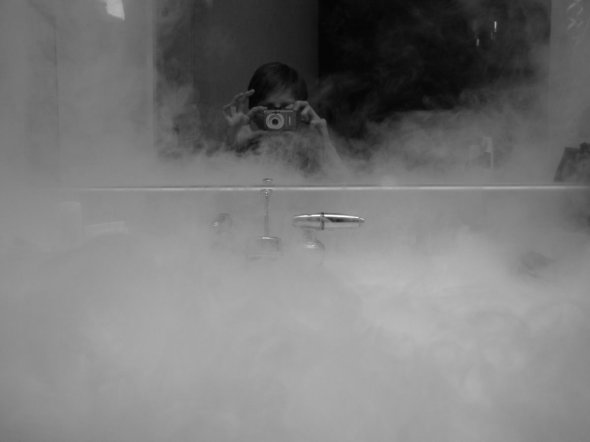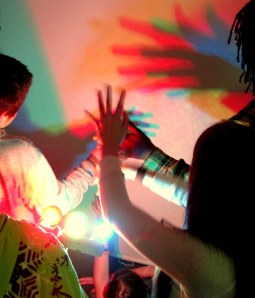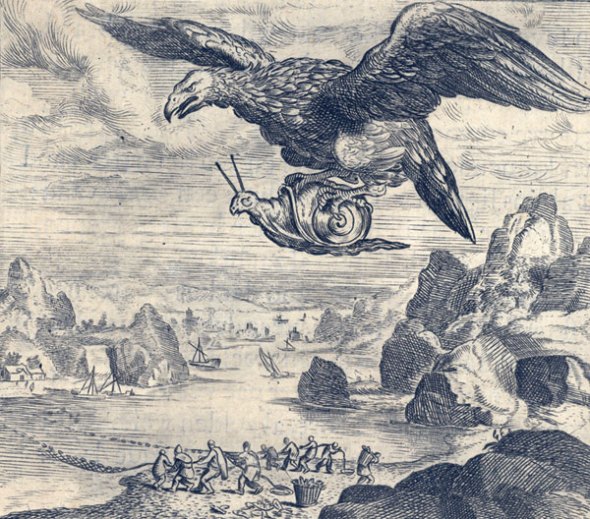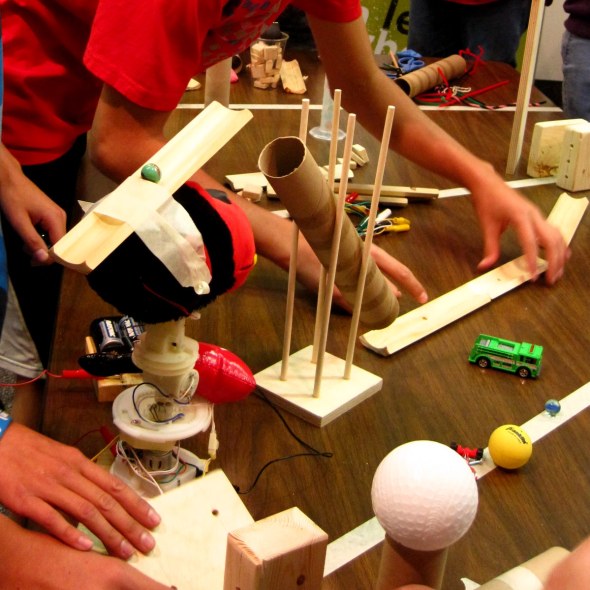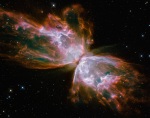Science Moment.
Posted: November 6, 2011 Filed under: Uncategorized | Tags: Leo On Wheels, Science, women Leave a commentI spent all Saturday with hundreds of science-loving middle school girls at Utah’s Expanding Your Horizons. The girls had dozens of workshops to choose from. I taught one on light.
The event is put on to “motivate young women in science and mathematics”, but from the conversations I had with these girls, most of them are already there. Beyond motivated. One quiet 6th grader pulled me aside and asked, “what’s your take on the recent finding that a neutrino traveled faster than the speed of light? How will it impact science if Einstein’s theories are wrong?”
. . .
During the final assembly, I sat by a 7th grader who cupped her hands over her heart and exclaimed:
–“This has been the best day of my whole year!”
—me, smiling: “You’ve had a good time today, huh?”
—7th grade girl: “OH yeah! I couldn’t come last year because my parents couldn’t afford it. But this year I saved up my allowance money so I could come.”
—me: “Wow. You paid your own way to come here? How much did it cost?”
—7th grade girl: “$16”
—me: “How much money do you get for allowance?”
—7th grade girl: “1 dollar a week.”
—me: “That’s impressive. You saved your allowance money for 16 weeks to be able to come spend a full Saturday doing science?”
—7th grade girl: “Well, one week I got 2 dollars.”
I still regret that I didn’t reach into my wallet and hand her the $20 bill I had sitting there, to help her come again next year.
Inspired by snails!
Posted: September 26, 2011 Filed under: Uncategorized | Tags: analogies, Science Leave a commentDo you believe some hurdles are insurmountable?
Sometimes I honestly relate to snails attempting to get from one end of a hot, dry side-walk to the other, while their leg-less body oozes out a trail of limited moisture reserves. (Despite the fact that snails unwittingly compete with me for my own garden vegetables, I am sympathetic to their plight under these impossible circumstances).
Well, dear snails, I’d like to thank you for inspiring me to believe in greater possibilities this week.
Scientists at the Smithsonian Tropical Research Institute recently published evidence that snails have long been migrating across massive stretches of land an ocean (let alone a 3-foot stretch of pavement). They accomplish this task—it turns out—by hitchhiking on the legs and bellies of shore birds. Brilliant.
This publication made me think. What kind of resources have I not been paying attention to?
Love, true love.
Posted: October 5, 2010 Filed under: Uncategorized | Tags: family, Science Leave a commentI heard a short anecdote from my mom today that warms my heart.
My kid brother (a senior in high school) sat down next to her on the couch. He looked her in the eyes and said, “Mom, I’m in love.” It was the one year anniversary for him and his girlfriend, so my mom immediately thought about her, I’m sure feeling a little nervous about where the conversation might be headed. Caleb continued, “…Mom, I am in love….with science.”
My mom ended with, “It just excites him so much. He is just pumped about science.”
Dear Caleb, I am in love too.
😉
follow-up on the punk-star primate’s autopsy
Posted: September 30, 2010 Filed under: Uncategorized | Tags: Leo On Wheels, Science Leave a commentI’ve been on the road for the last few weeks, sharing the love of science with middle schoolers. I contributed another entry to The Leonardo’s blog, sharing some of the ingenuity I’ve seen from these kids. Click on the link or the picture below to read about how one group of 8th graders used my de-constructed monkey in the creation of a chain reaction.
Autopsy on a rock-star monkey
Posted: September 15, 2010 Filed under: Uncategorized | Tags: Leo On Wheels, projects, Science Leave a commentI contributed the most recent blog post to theleonardo.org. Read the post at: http://blog.theleonardo.org/
Failure
Posted: March 2, 2010 Filed under: Uncategorized | Tags: failure, Science, spiritual 5 CommentsIn the midst of a great failure in my life, I have been spending considerable time pondering this topic. Three documents have been most influential in directing my thoughts:
1) This Harvard Commencement address by J.K. Rowling (I recommend you read or listen to it):
Click here to see the video.
Click here to read the text.
2) The December 2009 issue of WIRED Magazine (also highly recommended)

3) This book of scripture (brilliant book)
I have spent the bulk of my life fearing failure. That fear misguided my motivations in school; with regret I admit that too often what kept me up late studying was not a desire to learn but a desire to avoid any wrong answers. I have spent far more effort worrying and conjecturing about others’ perceptions of me than I have spent determining whether I myself was living authentically. This preoccupation with perfection too often kept me silent when I had questions to ask and thoughts to share. My misunderstandings about failure contributed little to self-improvement. I am quite convinced that these fears of failure have done more to thwart my personal progression and growth than any other force outside of me. In her commencement address I cited above, J.K. Rowling stated eloquently, “It is impossible to live without failing at something, unless you live so cautiously that you might as well not have lived at all – in which case, you fail by default.” In the wake of my most recent heart-wrenching failure, I have learned more about the human heart, more about the sacredness of human relationships, and more about our relation to God than any success of mine has ever taught me. Would I ever want to go through this again? Not a chance. Would I give up what I have learned from it all? No way. I believe I have no choice but to embrace failure.
Outside of my own inner-workings, I am also on a mission to inspire the middle-schoolers of Utah to embrace failure too. In attempting to encourage these budding young people to just play with our interactive science exhibits, I come against so many walls, so much resistance to just explore. My favorite question to ask right now is, “What have you discovered?” How can we have hope for discovering anything new if we are not willing to take risks? I was ironically comforted by studying science because I thought of it as a rock of objective certainty. I say ironic because in the field of science, I am continually learning, the vast majority of time is spent failing. I doubt this is unique to just the field of science. But, anyone interested in a science-inspired-fist-pumping-heart-pushing-mind-expanding read about the value of failure in the scientific realm should check out the December 2009 issue of WIRED magazine. I read the entire thing on my last flight home to Wisconsin. Even though it was a gift for my brother, I couldn’t help highlighting inspiring thoughts and folding over pages I wanted to revisit. The goal is not to avoid failure. The goal is to understand why something failed and to use that new knowledge to our advantage. Many of the worlds greatest inventions and discoveries were born from utter failures.
I was given some wise guidance a number of years back: “Success in life is not measured by an absences of problems, but is measured by your response to those problems.” This same person assured me my life would be full of problems and difficulties. Just what you want to hear, right? I am slowly coming to accept (and trying to embrace) that a life ‘full of problems’ is not really a problem at all. If the focus is to avoid failure, the result will be an avoidance of life. In the parable of the talents one man took the single talent he received from the Lord and buried it in the earth because he was afraid. God called this guy “wicked and slothful.” The sin was doing nothing. He was afraid and didn’t try. I presume it would have been fine with the Lord if this guy had just lost the talent in an honest attempt at growth. Instead he was punished for doing nothing (Matt 25:14-30).
This month I read the book of Job. I thought if I reminded myself that my life is not nearly as bad as his was, maybe I would feel a little bit better. What I learned from the reading is that God’s manner of teaching is unlike any other. ‘God is great, and we know him not.’ Most of the chapters in this book are dedicated to conjectures on why bad things happen to good people. In response to all this hypothesizing on why God does something or allows another thing to happen, God responds with a slew of questions that makes Job ‘lay [his] hand upon [his] mouth’. Here’s the first line of God’s questioning, “Gird up now thy loins like a man; for I will demand of thee, and answer thou me. Where wast thou when I laid the foundations of the earth? declare, if thou hast understanding…” The questioning continues through chapters 38, 39, 40, and 41 . I read them as if this beautiful onslaught of questioning was directed at me. Try it yourself. It’s humbling to say the least. Our human understanding and our vision are limited. Our reasonings very often just fall short. We must trust God. With this trust we can confidently move forward. We will inevitably fail. But who cares? That’s not the point. If we open ourselves to learning, we will inevitably grow. Success demands failure.
Generations
Posted: January 19, 2010 Filed under: Uncategorized | Tags: family, salt lake, Science, spiritual 6 Comments
This past week my mom and grandparents came out from Wisconsin to meet the newest (great) grandchild. It was a full, mind expanding week for these small-town Midwesterners. At one point I introduced my mom to some co-workers who apologized on behalf of the smoggy, cold Salt Lake weather. My mom replied in our heart-warming accent, “Oh, nO, this feels like spring tO us. This weather is great. We are just trying tO get Used tO all these big buildings. Da barns in WiscOnsin are nOt this big.” (I think she was joking, but that line still makes me chuckle. My mom is actually very well traveled).
Later that weekend I sat between my grandparents with my laptop and showed off some videos and photos from my work’s website to help them get a better idea of what I do. After the science-loving show-and-tell the following conversation ensued:
Grandma: “Harold, ask her to show you Moji Port.” (I learned that’s where my grandpa had been stationed in Japan during the Korean War, and just recently one of his closest buddies from that period of his life called him up saying that he could go on the internet and see photos of that same port).
Grandpa: “Oh, no, she’d need the internet for that.”
Me: “Actually, I am on the internet right now.”
Grandpa: “Well, do you have (pause) The Google?”
Me: “Why yes, I do have The Google!”
I proceeded to show my grandpa (who has never touched a computer in his life) the wonder that is Google Earth. We zoomed from satellite images of the farm where he grew up and raised his own family, to the other side of the globe where he served as a soldier 50 some years ago. This quiet man, who is usually just observing from his lazy-boy, kept pointing and telling stories, which trailed off in mutterings of “I was there… Gosh it’s changed a lot….” We found more photos of Moji Port on Flickr, which stirred more memories. I think we were all marveling at the wonders of modern technology and the impact it was having on my grandpa. After some time of silence my grandpa threw out a seemingly random question, “So, does anyone know what DNA looks like anyway??”
“Oh Grandpa, we do! Let me show you!” My grandparents only have high school degrees, and by the time the double helix had been discovered they were putting in long hours on the farm; DNA was familiar in name only. Using images I found on Wikipedia, I attempted to help my grandparents understand how it is possible to trace a strand of hair back to it’s original owner, and how it is possible to tell just from DNA samples how closely related two people are. My grandma was asking, “so the same exact DNA that in in my toe nail is also in my eyeball?”, when my little 2-year-old niece turned to show me something. She was playing a game on her uncle’s i-phone. While my grandpa will likely leave this world without ever using a computer, his great granddaughter will never know life without them.
The wonders did not stop there. That Sunday I witnessed the crumbling of a 30-year wall. When my mom joined The Church of Jesus Christ of Latter-day Saints, her Catholic parents were furious. They threatened to disown her as their child. She was the oldest of ten kids, raised in a home where holy water can be found at each entrance of the house and where a cross hangs above every door frame. While my mom continued to return home and we grandchildren were embraced with loving arms, we all note the silent tension when religion is spoke of. My grandparents didn’t attend our baptisms, strictly forbid other children from attending worship services with us, and frequently gave my mom anti-Mormon literature. In fact, my grandma would fly out to Utah only on the condition that they went to Mass on Sunday.
Last weekend, I was assigned to give a 10-minute talk on Christ-like Service during church, and I gave my grandparents an open invitation to come listen to me speak. When Sunday morning came, we attended Catholic Mass with my grandparents, and afterwards they joined us for Sacrament meeting, so they could listen to my talk. So simple. And so beautiful. That simple act of openness and love is still blowing me away.
As is the Microcosm so is the Macrocosm.
Posted: January 9, 2010 Filed under: Uncategorized | Tags: analogies, earth, Science Leave a commentWhile recently staring into a slushy puddle on the side of the road, a spot of oil spillage reminded me of the Hubble’s 2009 Advent Calendar. My memory tripped me back to 2001 when I learned the phrase: “as is the microcosm so is the macrocosm. I learned about this concept during a course I was taking entitled Science of Creative Intelligence. It was taught through 33 films by Maharishi Mahesh Yogi, who you might know from this song.
Here are some of my favorite Hubble Space Telescope images from the 2009 Advent Calendar:
And here are my microcosmic photos taken of the oil-splotched puddle on the side of the road:
Middle School Cafeterias
Posted: December 2, 2009 Filed under: Uncategorized | Tags: food, friends, Leo On Wheels, Science Leave a commentThis afternoon I broke a 12 year streak and ate hot lunch in a Middle School Cafeteria. The following image I found online summarizes the memories I have of this social and gastronomical misfortune.

Today’s adventure, however, was surprisingly pleasant. Provo’s Centennial Middle School fed me a tasty chicken salad in a whole wheat wrap and a green salad that contained no iceberg lettuce, but had everything from beet greens to cucumbers and radicchio in it. Dessert was shortcake with real strawberries and cream on top. $2.75. Who knew anyone in a public middle school eats this well?
I took a few strides back in time as I squeezed through the disordered clumps of awkward adolescents, tray and milk carton in hand, and asked a girl sitting alone at a table if I could join her for lunch. She wasn’t sure, since she was saving the 3 empty seats around her for some friends still waiting in line. It was probably my charming smile, or my very adult appearance, that finally won her acceptance. We pulled over another chair and soon these 3 seventh grade friends and I were talking about the usefulness of science, the nature of most school hot lunch menus, the instruments we play(ed) in band, and our favorite pets.
The best middle school humor I heard in our conversation came after I asked one girl if she lived in the country (she told me she had 25 pets). Her friend cut in to respond for her: “of course she does, it’s called the United States!” When the bell rang and the lunchroom again became a chaotic hive of not-quite-adults, all three of my lunch-mates thanked me for sitting with them and for bringing ‘fun science stuff’ to their school. How tender is that?!
alone in my hotel room…
Posted: October 31, 2009 Filed under: Uncategorized | Tags: Leo On Wheels, Science, Self Portraits 2 CommentsAfter our Leo on Wheels Community Nights, where we open up our traveling science museum to anyone in the town who wants to come, I take our left-over dry ice back to the hotel room with me. This ritual was the perfect welcome to the Halloween Spirit.


